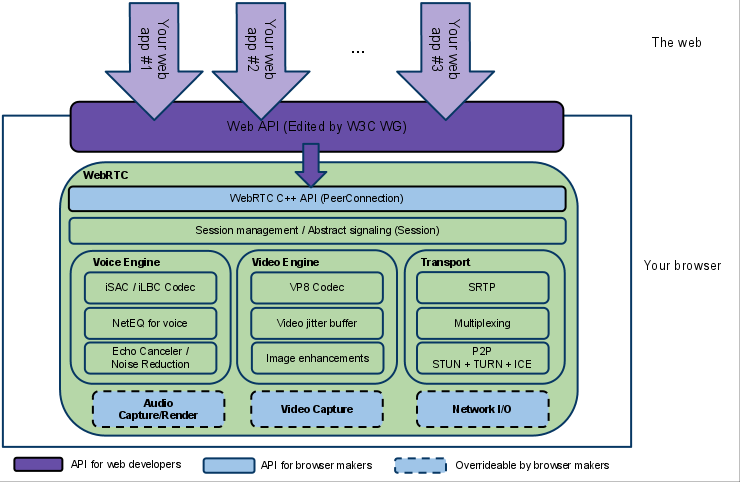WebRTC
RTCPeerConnection
For technical reasons, the title of this article is not the text used to call this API. Instead, use RTCPeerConnection
Summary
WebRTC implements open standards for real-time, plugin-free video, audio and data communication.
Real-time communication without plugins
WebRTC is a new front in the long war for an open and unencumbered web.
— Brendan Eich, inventor of JavaScript
Imagine a world where your phone, TV and computer could all communicate on a common platform. Imagine it was easy to add video chat to your web application. That’s the vision of WebRTC.
Want to try it out? WebRTC is available now in Google Chrome and Firefox.
A good place to begin is the simple video chat application at apprtc.appspot.com:
- Open the page in Chrome (you don’t need to set about:flags)
- Click the Allow button to let the app use your web cam.
- Open the URL displayed at the bottom of the page in a new tab or window or, better still, on a different computer.
There is a walkthrough of the code later in this article.
Quick start
Haven’t got time to read this article, or just want code?
- Get an overview of WebRTC from Justin Uberti’s Google I/O video.
- If you haven’t used getUserMedia, take a look at the HTML5 Rocks article on the subject, and view the source for the simple example at simpl.info/gum and Eric Bidelman's photobooth demo.
- Get to grips with the RTCPeerConnection API by reading through the simple example below and the demo at simpl.info/pc, which implements WebRTC on a single web page.
- Learn more about how WebRTC uses servers for signaling, data communication, firewall and NAT traversal, by reading through the code and the console logs from the video chat demo at apprtc.appspot.com.
A very short history of WebRTC
One of the last major challenges for the web is to enable human communication via voice and video: Real Time Communication, RTC for short. RTC should be as natural in a web application as entering text in a text input. Without it, we’re limited in our ability to innovate and develop new ways for people to interact.
Historically, RTC has been corporate and complex, requiring expensive audio and video technologies to be licensed or developed in house. Integrating RTC technology with existing content, data and services has been difficult and time consuming, particularly on the web.
Gmail video chat became popular in 2008, and in 2011 Google introduced Hangouts, which use the Google Talk service (as does Gmail). Google bought GIPS, a company which had developed many components required for RTC, such as codecs and echo cancellation techniques. Google open sourced the technologies developed by GIPS and engaged with relevant standards bodies at the IETF and W3C to ensure industry consensus. In May 2011, Ericsson built the first implementation of WebRTC.
WebRTC has now implemented open standards for real-time, plugin-free video, audio and data communication. The need is real:
- Many web services already use RTC, but need downloads, native apps or plugins. These includes Skype, Facebook (which uses Skype) and Google Hangouts (which use the Google Talk plugin).
- Downloading, installing and updating plugins can be complex, error prone and annoying.
- Plugins can be difficult to deploy, debug, troubleshoot, test and maintain—and may require licensing and integration with complex, expensive technology. It’s often difficult to persuade people to install plugins in the first place!
The guiding principles of the WebRTC project are that its APIs should be open source, free, standardized, built into web browsers and more efficient than existing technologies.
Where are we now?
WebRTC implements three APIs:
- MediaStream/getUserMedia: get access to data streams, such as from the user’s camera and microphone. (specs, docs)
- RTCPeerConnection: audio or video calling, with facilities for encryption and bandwidth management. (specs, docs)
- RTCDataChannel: peer-to-peer communication of generic data. (specs, docs)
getUserMedia is available in Chrome, Opera and Firefox Nightly/Aurora. Take a look at the cross-browser demo of getUserMedia at simpl.info/gum (though for Firefox you’ll need to set preferences). Also check out Chris Wilson’s amazing examples of using getUserMedia as input for Web Audio.
webkitRTCPeerConnection is now in Chrome stable and it’s flagless. (A word of explanation about the name: after several iterations, RTCPeerConnection is currently implemented by Chrome as webkitRTCPeerConnection and by Firefox Aurora/Nightly as mozRTCPeerConnection. Other names and implementations have been deprecated. When the standards process has stabilized, the prefixes will be removed.) There’s an ultra-simple demo of Chrome’s RTCPeerConnection implementation at simpl.info/pc and a great video chat application at apprtc.appspot.com.
RTCDataChannel is supported by Chrome 25 and above, but is behind a flag before Chrome 27. RTCPeerConnection and RTCDataChannel have also been in desktop Firefox Nightly and Aurora.
WebRTC is also implemented by the Ericsson Bowser browser which runs on iOS and Android:
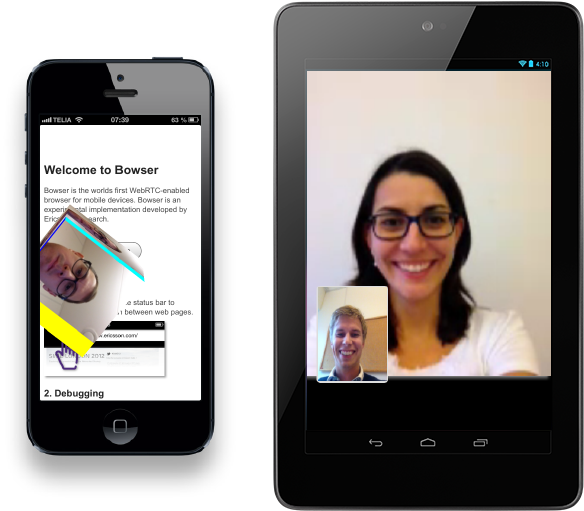
WebRTC functionality is available in Internet Explorer via Chrome Frame, and Skype (acquired by Microsoft in 2011) is reputedly planning to use WebRTC. WebRTC has also been integrated with WebKitGTK+ and Qt native apps.
A word of warning
Be skeptical of reports that a platform 'supports WebRTC’. Often this actually just means that getUserMedia is supported, but not any of the other RTC components.
My first WebRTC
WebRTC applications need to do several things:
- Get streaming audio, video or other data.
- Get network information such as IP address and port, and exchange this with other WebRTC clients (known as peers) to enable connection, even through NATs and firewalls.
- Coordinate signaling communication to report errors and initiate or close sessions. (There is detailed discussion of the network and signaling aspects of WebRTC below.)
- Exchange information about media and client capability, such as resolution and codecs.
- Communicate streaming audio, video or data.
MediaStream (aka getUserMedia)
The MediaStream (specs, docs) represents synchronized streams of media. For example, a stream taken from camera and microphone input has synchronized video and audio tracks. (Don’t confuse MediaStream tracks with the <track> element, which is something entirely different.)
Probably the easiest way to understand MediaStream is to look at it in the wild:
- In Chrome, open the demo at simpl.info/gum
- Open the console
- Inspect the
streamvariable, which is in global scope.
Each MediaStream has an input, which might be a LocalMediaStream generated by navigator.getUserMedia(), and an output, which might be passed to a video element or an RTCPeerConnection.
The getUserMedia() method takes three parameters:
- A constraints object.
- A success callback which, if called, is passed a LocalMediaStream.
- A failure callback which, if called, is passed an error object.
Each LocalMediaStream (i.e. a MediaStream local to the browser) has a label (such as’Xk7EuLhsuHKbnjLWkW4yYGNJJ8ONsgwHBvLQ’) and audioTracks and videoTracks properties, each of which is a MediaStreamTrackList.
For the simpl.info/gum example, audioTracks and videoTracks each have one member, i.e. one MediaStreamTrack. Each MediaStreamTrack has a kind (‘video’ or ‘audio’), and a label (something like 'FaceTime HD Camera (Built-in)'), and represents one or more channels of either audio or video. In this case, there is only one audio and one video track, but it is easy to imagine use cases where there are more: for example, a chat application that enables input from front camera, rear camera a microphone, and a ‘screenshared’ application.
In Chrome, the URL.createObjectURL() method converts a LocalMediaStream to a Blob URL which can be set as the src of a video element. (In Firefox and Opera, the src of the video can be set from the stream itself.) Since version 25, Chrome allows audio data from getUserMedia to be passed to an audio or video element (but note that by default the media element will be muted in this case.
getUserMedia can also be used as an input node for the Web Audio API:
function gotStream(stream) {
var audioContext = 'webkitAudioContext' in window ?
new webkitAudioContext() : new AudioContext();
var mediaStreamSource = audioContext.createMediaStreamSource(stream);
mediaStreamSource.connect(audioContext.destination);
}
navigator.webkitGetUserMedia({audio:true}, gotStream);
Chrome apps and extensions can also incorporate getUserMedia. Adding audioCapture and/or videoCapture permissions to the manifest enables permission to be requested and granted only once, on installation. Thereafter the user is not asked for permission for camera or microphone access. Likewise, on pages using HTTPS, calls to getUserMedia() in Chrome will cause an Always Allow button to be displayed in the browser’s infobar: permission only has to be granted once.
Chrome apps also now make it possible to share a live ‘video’ of a browser tab via the experimental chrome.tabCapture API. For a screencast, code and more information, see the HTML5 Rocks update: Screensharing with WebRTC.
The intention is eventually to enable a MediaStream for any streaming data source, not just a camera or microphone, which would enable collection of arbitrary real-time data, for example from sensors or other inputs.
Note that getUserMedia() must be used on a server, not the local file system, otherwise a PERMISSION_DENIED: 1 error will be thrown.
Resolution Constraints
Constraints have been implemented in Chrome 24 and above. These can be used to set values for video resolution for getUserMedia() and RTCPeerConnection addStream() calls.
There’s an example at simpl.info/getusermedia/constraints.
One gotcha: getUserMedia constraints set in one browser tab affect constraints for all tabs opened subsequently. Setting a disallowed value for constraints gives a rather cryptic error message:
navigator.getUserMedia error: NavigatorUserMediaError {code: 1, PERMISSION_DENIED: 1}
Signaling: session control, network and media information
WebRTC uses RTCPeerConnection to communicate streaming data between browsers (aka peers), but also needs a mechanism to coordinate communication and to send control messages, a process known as signaling. Signaling methods and protocols are not specified by WebRTC: signaling is not part of the RTCPeerConnection API.
Instead, WebRTC app developers can choose whatever messaging protocol they prefer, such as SIP or XMPP, and any appropriate duplex (two-way) communication channel. The apprtc.appspot.com example uses XHR and the Channel API as the signaling mechanism. Silvia Pfeiffer and others have demonstrated WebRTC signaling via WebSocket.
Signaling is used to exchange three types of information.
- Session control messages: to initialize or close communication and report errors.
- Network configuration: to the outside world, what’s my computer’s IP address and port?
- Media capabilities: what codecs and resolutions can be handled by my browser and the browser it wants to communicate with?
The exchange of information via signaling must have completed successfully before peer-to-peer streaming can begin.
For example, imagine Alice wants to communicate with Bob. Here’s a code sample from the WebRTC W3C Working Draft, which shows the signaling process in action. (The code assumes the existence of some signaling mechanism, created in the createSignalingChannel() method. Also note that on Chrome, RTCPeerConnection is currently prefixed.)
var signalingChannel = createSignalingChannel();
var pc;
var configuration = ...;
// run start(true) to initiate a call
function start(isCaller) {
pc = new RTCPeerConnection(configuration);
// send any ice candidates to the other peer
pc.onicecandidate = function (evt) {
signalingChannel.send(JSON.stringify({ "candidate": evt.candidate }));
};
// once remote stream arrives, show it in the remote video element
pc.onaddstream = function (evt) {
remoteView.src = URL.createObjectURL(evt.stream);
};
// get the local stream, show it in the local video element and send it
navigator.getUserMedia({ "audio": true, "video": true }, function (stream) {
selfView.src = URL.createObjectURL(stream);
pc.addStream(stream);
if (isCaller)
pc.createOffer(gotDescription);
else
pc.createAnswer(pc.remoteDescription, gotDescription);
function gotDescription(desc) {
pc.setLocalDescription(desc);
signalingChannel.send(JSON.stringify({ "sdp": desc }));
}
});
}
signalingChannel.onmessage = function (evt) {
if (!pc)
start(false);
var signal = JSON.parse(evt.data);
if (signal.sdp)
pc.setRemoteDescription(new RTCSessionDescription(signal.sdp));
else
pc.addIceCandidate(new RTCIceCandidate(signal.candidate));
};
First up, Alice and Bob exchange network information. (The expression ‘finding candidates’ refers to the process of finding network interfaces and ports using the ICE framework.)
- Alice creates an RTCPeerConnection object with an
onicecandidatehandler. - The handler is run when network candidates become available.
- Alice sends serialized candidate data to Bob, via whatever signaling channel they are using: WebSocket or some other mechanism.
- When Bob gets a candidate message from Alice, he calls
addIceCandidate, to add the candidate to the remote peer description.
WebRTC clients (known as peers, aka Alice and Bob) also need to ascertain and exchange local and remote audio and video media information, such as resolution and codec capabilities. Signaling to exchange media configuration information proceeds by exchanging an offer and an answer using the Session Description Protocol (SDP):
- Alice runs the RTCPeerConnection
createOffer()method. The callback argument of this is passed an RTCSessionDescription: Alice’s local session description. - In the callback, Alice sets the local description using
setLocalDescription()and then sends this session description to Bob via their signaling channel. - Bob sets the description Alice sent him as the remote description (using
setRemoteDescription()). - Bob runs the RTCPeerConnection
createAnswer()method, passing it the remote description he got from Alice, so a local session can be generated that is compatible with hers. ThecreateAnswer()callback is passed an RTCSessionDescription: Bob sets that as the local description and sends it to Alice. - When Alice gets Bob’s session description, she sets that as the remote description with
setRemoteDescription. - Ping!
RTCSessionDescription objects are blobs that conform to the Session Description Protocol, SDP. Serialized, an SDP object looks like this:
v=0
o=- 3883943731 1 IN IP4 127.0.0.1
s=
t=0 0
a=group:BUNDLE audio video
m=audio 1 RTP/SAVPF 103 104 0 8 106 105 13 126
// ...
a=ssrc:2223794119 label:H4fjnMzxy3dPIgQ7HxuCTLb4wLLLeRHnFxh810
The acquisition and exchange of network and media information can be done simultaneously, but both processes must have completed before audio and video streaming between peers can begin.
The offer/answer architecture described above is called JSEP, JavaScript Session Establishment Protocol. (There’s an excellent animation explaining the process of signaling and streaming in Ericsson’s demo video for its first WebRTC implementation.)
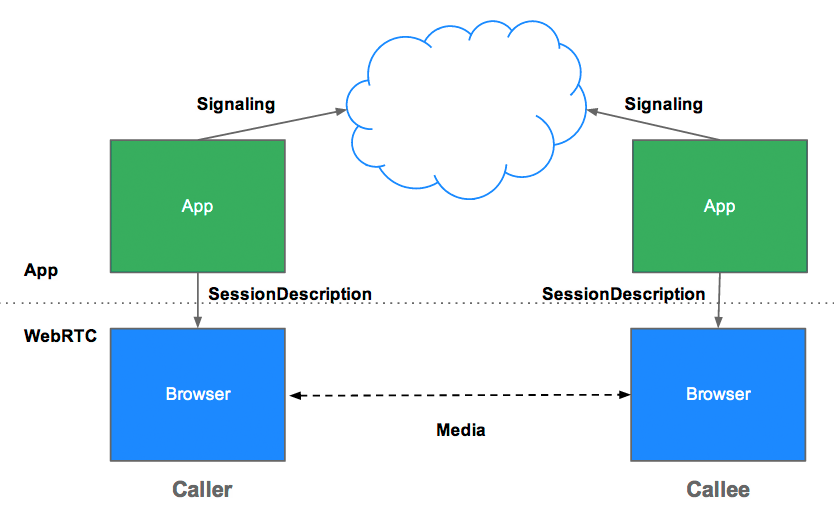
Once the signaling process has completed successfully, data can be streamed directly peer to peer, between the caller and callee—or if that fails, via an intermediary server (more about that below). Streaming is the job of RTCPeerConnection.
RTCPeerConnection
RTCPeerConnection (specs, docs) is the WebRTC component that handles stable and efficient communication of streaming data between peers.
Below is a WebRTC architecture diagram showing the role of RTCPeerConnection. As you will notice, the green parts are complex!
From a JavaScript perspective, the main thing to understand from this diagram is that RTCPeerConnection shields web developers from the myriad complexities that lurk beneath. The codecs and protocols used by WebRTC do a huge amount of work to make real-time communication possible, even over unreliable networks:
- packet loss concealment
- echo cancellation
- bandwidth adaptivity
- dynamic jitter buffering
- automatic gain control
- noise reduction and suppression
- image 'cleaning’.
The W3C code above shows a simplified example of WebRTC from a signaling perspective. Below are walkthroughs of two working WebRTC applications: the first is a simple example to demonstrate RTCPeerConnection; the second is a fully operational video chat client.
RTCPeerConnection sans servers
The code below is taken from the ‘single page’ WebRTC demo at webrtc-demos.appspot.com, which has local and remote RTCPeerConnection (and local and remote video) on one web page. This doesn’t constitute anything very useful—caller and callee are on the same page—but it does make the workings of the RTCPeerConnection API a little clearer, since the RTCPeerConnection objects on the page can exchange data and messages directly without having to use intermediary signaling mechanisms.
One gotcha: the optional second ‘constraints’ parameter of the RTCPeerConnection() constructor is different from the constraints type used by getUserMedia(): see w3.org/TR/webrtc/#constraints for more information.
In this example, pc1 represents the local peer (caller) and pc2 represents the remote peer (callee).
Caller
Create a new RTCPeerConnection and add the stream from
getUserMedia():// servers is an optional config file (see TURN and STUN discussion below) pc1 = new webkitRTCPeerConnection(servers); // ... pc1.addStream(localstream);Create an offer and set it as the local description for
pc1and as the remote description forpc2. This can be done directly in the code without using signaling, because both caller and callee are on the same page:pc1.createOffer(gotDescription1); //... function gotDescription1(desc){ pc1.setLocalDescription(desc); trace("Offer from pc1 \n" + desc.sdp); pc2.setRemoteDescription(desc); pc2.createAnswer(gotDescription2); }
Callee
Create
pc2and, when the stream frompc1is added, display it in a video element:pc2 = new webkitRTCPeerConnection(servers); pc2.onaddstream = gotRemoteStream; //... function gotRemoteStream(e){ vid2.src = URL.createObjectURL(e.stream); }
RTCPeerConnection plus servers
In the real world, WebRTC needs servers, however simple, so the following can happen:
- Users discover each other and exchange ‘real world’ details such as names.
- WebRTC client applications (peers) exchange network information.
- Peers exchange data about media such as video format and resolution.
- WebRTC client applications traverse NAT gateways and firewalls.
In other words, WebRTC needs four types of server-side functionality:
- User discovery and communication.
- Signaling.
- NAT/firewall traversal.
- Relay servers in case peer-to-peer communication fails.
NAT traversal, peer-to-peer networking, and the requirements for building a server app for user discovery and signaling, are beyond the scope of this article. Suffice to say that the STUN protocol and its extension TURN are used by the ICE framework to enable RTCPeerConnection to cope with NAT traversal and other network vagaries.
ICE is a framework for connecting peers, such as two video chat clients. Initially, ICE tries to connect peers directly, with the lowest possible latency, via UDP. In this process, STUN servers have a single task: to enable a peer behind a NAT to find out its public address and port. (Google has a couple of STUN severs, one of which is used in the apprtc.appspot.com example.)
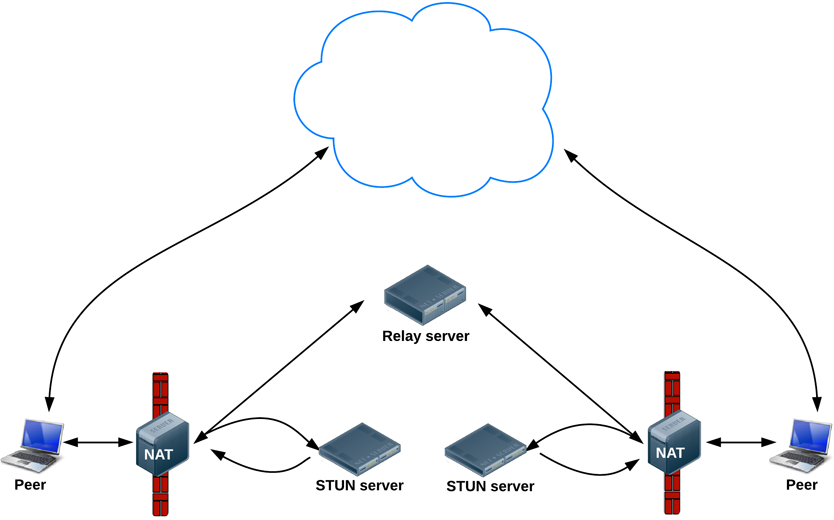
If UDP fails, ICE tries TCP: first HTTP, then HTTPS. If direct connection fails—in particular, because of enterprise NAT traversal and firewalls—ICE uses an intermediary (relay) TURN server. In other words, ICE will first use STUN with UDP to directly connect peers and, if that fails, will fall back to a TURN relay server. The expression ‘finding candidates’ refers to the process of finding network interfaces and ports.
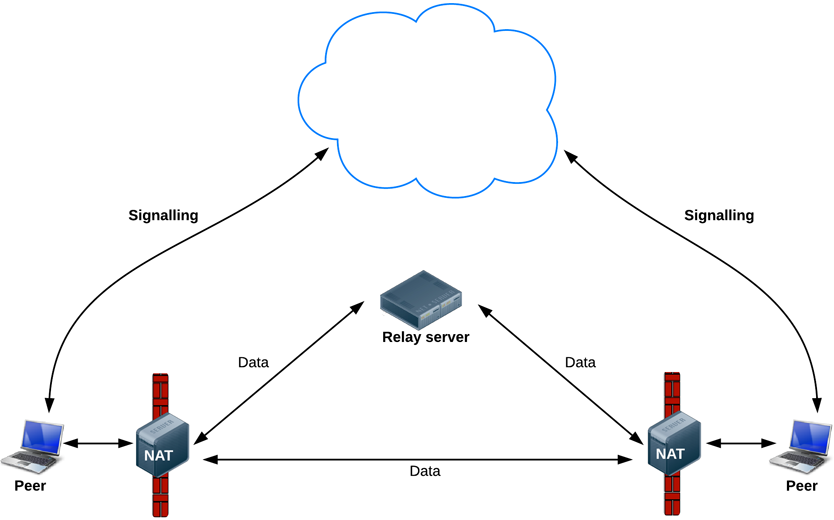
To find out more about how set up a server to deal with signaling and user discovery, take a look at the code repository for the apprtc.appspot.com demo, which is at code.google.com/p/webrtc-samples/source/browse/trunk/apprtc/. This uses the Google App Engine Channel API. For information about using a WebSocket server for signaling, check out Silvia Pfeiffer’s WebSocket WebRTC app.
A simple video chat client
A good place to try out WebRTC, complete with signaling and NAT/firewall traversal using a STUN server, is the video chat demo at apprtc.appspot.com. This app uses adapter.js to cope with different RTCPeerConnection and getUserMedia() implementations.
The code is deliberately verbose in its logging: check the console to understand the order of events. Below we give a detailed walk-through of the code.
What’s going on?
The demo starts by running the initalize() function:
function initialize() {
console.log("Initializing; room=99688636.");
card = document.getElementById("card");
localVideo = document.getElementById("localVideo");
miniVideo = document.getElementById("miniVideo");
remoteVideo = document.getElementById("remoteVideo");
resetStatus();
openChannel('AHRlWrqvgCpvbd9B-Gl5vZ2F1BlpwFv0xBUwRgLF/* ...*/');
doGetUserMedia();
}
Note that values used in the JavaScript, such as the room variable and the token used by openChannel(), are provided by the Google App Engine app itself: take a look at the index.html template in the repository to see what values are added.
This code initializes variables for the HTML video elements that will display video streams from the local camera (localVideo) and from the camera on the remote client (remoteVideo). resetStatus() simply sets a status message.
The openChannel() function sets up messaging between WebRTC clients:
function openChannel(channelToken) {
console.log("Opening channel.");
var channel = new goog.appengine.Channel(channelToken);
var handler = {
'onopen': onChannelOpened,
'onmessage': onChannelMessage,
'onerror': onChannelError,
'onclose': onChannelClosed
};
socket = channel.open(handler);
}
For signaling, this demo uses the Google App Engine Channel API, which enables messaging between JavaScript clients without polling. (WebRTC signaling is covered in more detail above).
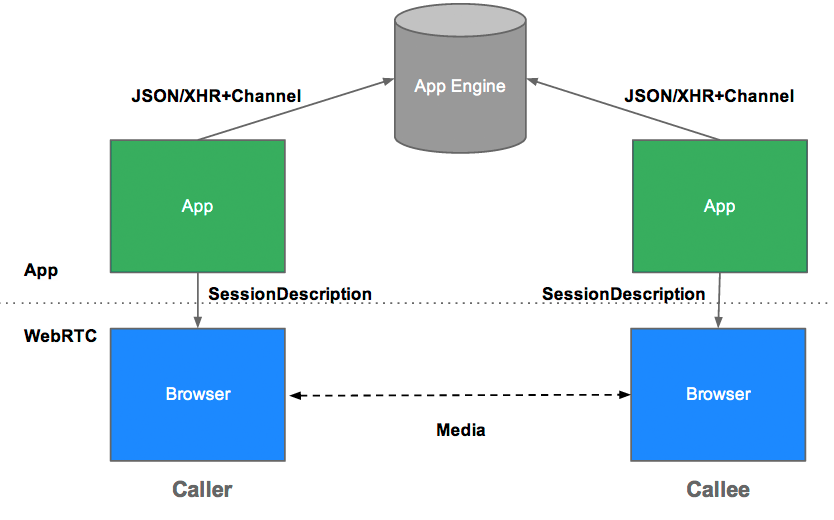
Establishing a channel with the Channel API works like this:
- Client A generates a unique ID.
- Client A requests a Channel token from the App Engine app, passing its ID.
- App Engine app requests a channel and a token for the client’s ID from the Channel API.
- App sends the token to Client A.
- Client A opens a socket and listens on the channel set up on the server.
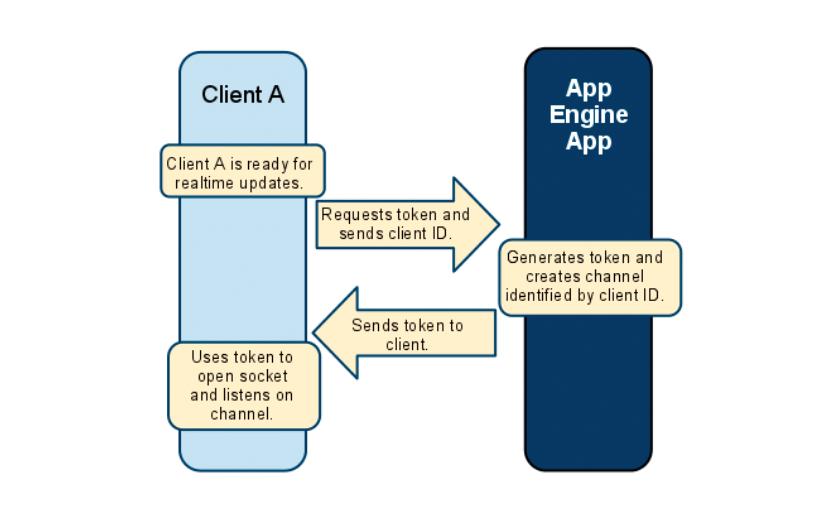
Sending a message works like this:
- Client B makes a POST request to the App Engine app with an update.
- The App Engine app passes a request to the channel.
- The channel carries a message to Client A.
- Client A’s onmessage callback is called.
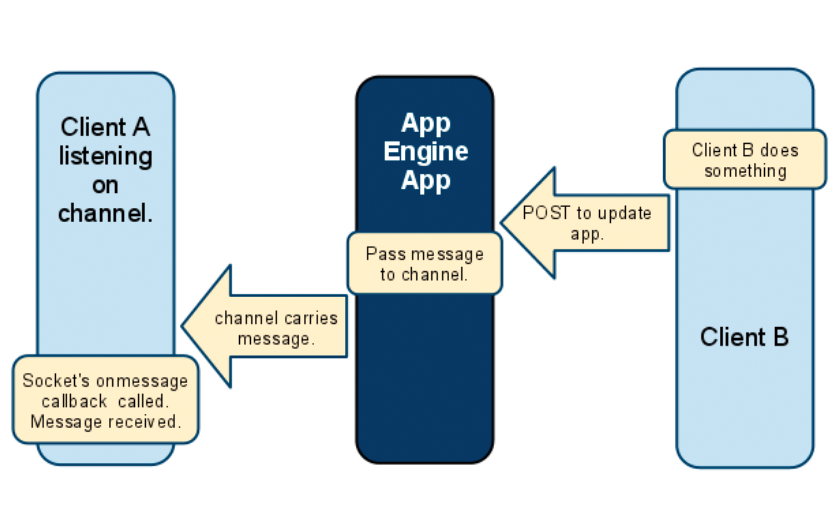
Just to reiterate: signaling messages are communicated via whatever mechanism the developer chooses: the signaling mechanism is not specified by WebRTC. The Channel API is used in this demo, but other methods (such as WebSocket) could be used instead.
After the call to openChannel(), the getUserMedia() function called by initialize() checks if the browser supports the getUserMedia API. (Find out more about getUserMedia on HTML5 Rocks.) If all is well, onUserMediaSuccess is called:
function onUserMediaSuccess(stream) {
console.log("User has granted access to local media.");
// Call the polyfill wrapper to attach the media stream to this element.
attachMediaStream(localVideo, stream);
localVideo.style.opacity = 1;
localStream = stream;
// Caller creates PeerConnection.
if (initiator) maybeStart();
}
This causes video from the local camera to be displayed in the localVideo element, by creating an object (Blob) URL for the camera’s data stream and then setting that URL as the src for the element. (createObjectURL is used here as a way to get a URI for an ‘in memory’ binary resource, i.e. the LocalDataStream for the video.) The data stream is also set as the value of localStream, which is subsequently made available to the remote user.
At this point, initiator has been set to 1 (and it stays that way until the caller’s session has terminated) so maybeStart() is called:
function maybeStart() {
if (!started && localStream && channelReady) {
// ...
createPeerConnection();
// ...
pc.addStream(localStream);
started = true;
// Caller initiates offer to peer.
if (initiator)
doCall();
}
}
This function uses a handy construct when working with multiple asynchronous callbacks: maybeStart() may be called by any one of several functions, but the code in it is run only when localStream has been defined and channelReady has been set to true and communication hasn’t already started. So—if a connection hasn’t already been made, and a local stream is available, and a channel is ready for signaling, a connection is created and passed the local video stream. Once that happens, started is set to true, so a connection won’t be started more than once.
RTCPeerConnection: making a call
createPeerConnection(), called by maybeStart(), is where the real action begins:
function createPeerConnection() {
var pc_config = {"iceServers": [{"url": "stun:stun.l.google.com:19302"}]};
try {
// Create an RTCPeerConnection via the polyfill (adapter.js).
pc = new RTCPeerConnection(pc_config);
pc.onicecandidate = onIceCandidate;
console.log("Created RTCPeerConnnection with config:\n" + " \"" +
JSON.stringify(pc_config) + "\".");
} catch (e) {
console.log("Failed to create PeerConnection, exception: " + e.message);
alert("Cannot create RTCPeerConnection object; WebRTC is not supported by this browser.");
return;
}
pc.onconnecting = onSessionConnecting;
pc.onopen = onSessionOpened;
pc.onaddstream = onRemoteStreamAdded;
pc.onremovestream = onRemoteStreamRemoved;
}
The underlying purpose is to set up a connection, using a STUN server, with onIceCandidate() as the callback (see above for an explanation of ICE, STUN and ‘candidate’). Handlers are then set for each of the RTCPeerConnection events: when a session is connecting or open, and when a remote stream is added or removed. In fact, in this example these handlers only log status messages—except for onRemoteStreamAdded(), which sets the source for the remoteVideo element:
function onRemoteStreamAdded(event) {
// ...
miniVideo.src = localVideo.src;
attachMediaStream(remoteVideo, event.stream);
remoteStream = event.stream;
waitForRemoteVideo();
}
Once createPeerConnection() has been invoked in maybeStart(), a call is intitiated by creating and offer and sending it to the callee:
function doCall() {
console.log("Sending offer to peer.");
pc.createOffer(setLocalAndSendMessage, null, mediaConstraints);
}
The offer creation process here is similar to the no-signaling example above but, in addition, a message is sent to the remote peer, giving a serialized SessionDescription for the offer. This process is handled by setLocalAndSendMessage():
function setLocalAndSendMessage(sessionDescription) {
// Set Opus as the preferred codec in SDP if Opus is present.
sessionDescription.sdp = preferOpus(sessionDescription.sdp);
pc.setLocalDescription(sessionDescription);
sendMessage(sessionDescription);
}
Signaling with the Channel API
The onIceCandidate() callback invoked when the RTCPeerConnection is successfully created in createPeerConnection() sends information about candidates as they are 'gathered’:
function onIceCandidate(event) {
if (event.candidate) {
sendMessage({type: 'candidate',
label: event.candidate.sdpMLineIndex,
id: event.candidate.sdpMid,
candidate: event.candidate.candidate});
} else {
console.log("End of candidates.");
}
}
Outbound messaging, from the client to the server, is done by sendMessage() with an XHR request:
function sendMessage(message) {
var msgString = JSON.stringify(message);
console.log('C->S: ' + msgString);
path = '/message?r=99688636' + '&u=92246248';
var xhr = new XMLHttpRequest();
xhr.open('POST', path, true);
xhr.send(msgString);
}
XHR works fine for sending signaling messages from the client to the server, but some mechanism is needed for server-to-client messaging: this application uses the Google App Engine Channel API. Messages from the API (i.e. from the App Engine server) are handled by processSignalingMessage():
function processSignalingMessage(message) {
var msg = JSON.parse(message);
if (msg.type === 'offer') {
// Callee creates PeerConnection
if (!initiator && !started)
maybeStart();
pc.setRemoteDescription(new RTCSessionDescription(msg));
doAnswer();
} else if (msg.type === 'answer' && started) {
pc.setRemoteDescription(new RTCSessionDescription(msg));
} else if (msg.type === 'candidate' && started) {
var candidate = new RTCIceCandidate({sdpMLineIndex:msg.label,
candidate:msg.candidate});
pc.addIceCandidate(candidate);
} else if (msg.type === 'bye' && started) {
onRemoteHangup();
}
}
If the message is an answer from a peer (a response to an offer), RTCPeerConnection sets the remote SessionDescription and communication can begin. If the message is an offer (i.e. a message from the callee) RTCPeerConnection sets the remote SessionDescription, sends an answer to the callee, and starts connection by invoking the RTCPeerConnection startIce() method:
function doAnswer() {
console.log("Sending answer to peer.");
pc.createAnswer(setLocalAndSendMessage, null, mediaConstraints);
}
And that’s it! The caller and callee have discovered each other and exchanged information about their capabilities, a call session is initiated, and real-time data communication can begin.
Network topologies
WebRTC as currently implemented only supports one-to-one communication, but could be used in more complex network scenarios: for example, with multiple peers each communicating each other directly, peer-to-peer, or via a centralized server.
Many existing WebRTC apps only demonstrate communication between web browsers, but gateway servers can enable a WebRTC app running on a browser to interact with devices such as telephones, and with VOIP systems. In May 2012, Doubango Telecom open-sourced the sipml5 SIP client, built with WebRTC and WebSocket which (among other potential uses) enables video calls between browsers and apps running on iOS or Android. At Google I/O in 2012, Tethr and Tropo demonstrated a framework for disaster communications 'in a briefcase’, using an OpenBTS cell to enable communications between feature phones and computers via WebRTC. Telephone communication without a carrier!
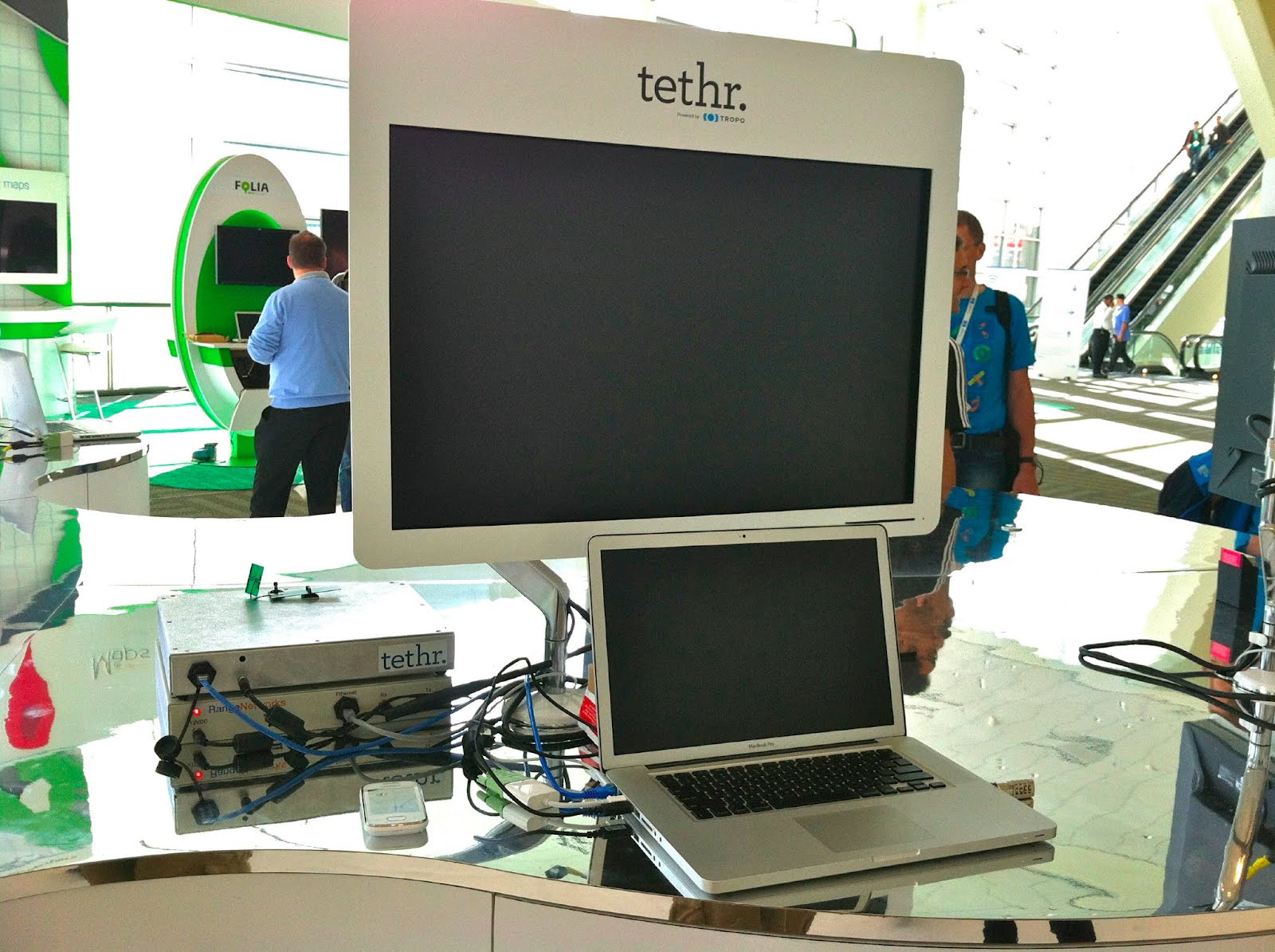
RTCDataChannel
As well as audio and video, WebRTC supports real-time communication for other types of data.
The RTCDataChannel API (specs, docs) enables peer-to-peer exchange of arbitrary data, with low latency and high throughput.
There are many potential use cases for the API, including:
- Gaming
- Remote desktop applications
- Real-time text chat
- File transfer
- Decentralized networks
The API has several features to make the most of RTCPeerConnection and enable powerful and flexible peer-to-peer communication:
- Leveraging of RTCPeerConnection session setup.
- Multiple simultaneous channels, with prioritization.
- Reliable and unreliable delivery semantics.
- Built-in security (DTLS) and congestion control.
- Ability to use with or without audio or video.
The syntax is deliberately similar to WebSocket, with send() and onmessage, as you will see in the code sample below:
// RTCPeerConnection setup and offer-answer exchange omitted
var dc1 = pc1.createDataChannel("mylabel"); // create the sending RTCDataChannel (reliable mode)
var dc2 = pc2.createDataChannel("mylabel"); // create the receiving RTCDataChannel (reliable mode)
// append received RTCDataChannel messages to a textarea
var receiveTextarea = document.querySelector("textarea#receive");
dc2.onmessage = function(event) {
receiveTextarea.value += event.data;
};
var sendInput = document.querySelector("input#send");
// send message over the RTCDataChannel
function onSend() {
dc1.send(sendInput.value);
}
RTCDataChannel is a WebRTC API for high performance, low latency, peer-to-peer communication of arbitrary data. The API is simple—similar to WebSocket—but communication occurs directly between browsers, so RTCDataChannel can be much faster than WebSocket even if a relay (TURN) server is required when ‘hole punching’ to cope with firewalls and NATs fails.
RTCDataChannel is in version 25 of Chrome, behind a flag. This version is for experimentation only, is not fully functional, and communication isn’t possible with the Firefox implementation. RTCDataChannel in Chrome 26 is more stable, flagless and compatible with RTCDataChannel in Firefox.
Firefox Nightly/Aurora supports mozGetUserMedia, mozRTCPeerConnection and RTCDataChannel (but don’t forget to set your about:config preferences!)
Here’s a screenshot of RTCDataChannel running in Firefox:
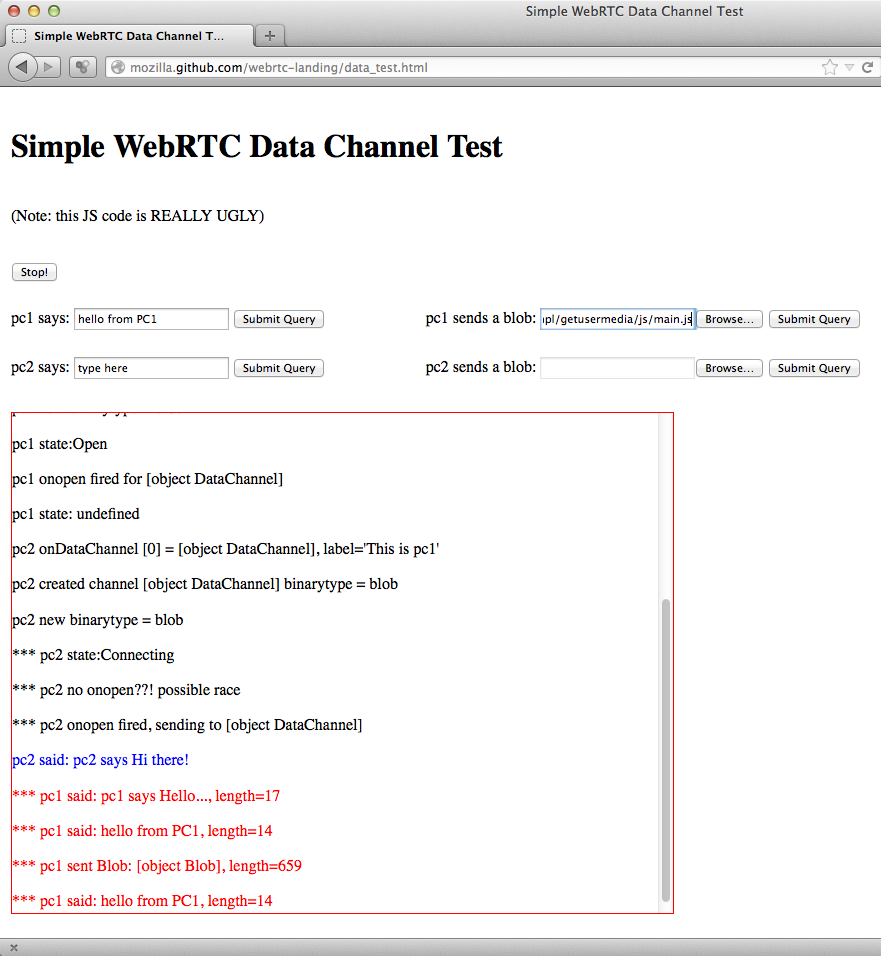
This demo is at http://mozilla.github.com/webrtc-landing/data_test.html. Here’s a code snippet:
pc1.onconnection = function() {
log("pc1 onConnection ");
dc1 = pc1.createDataChannel("This is pc1",{}); // reliable (TCP-like)
dc1 = pc1.createDataChannel("This is pc1",{outOfOrderAllowed: true, maxRetransmitNum: 0}); // unreliable (UDP-like)
log("pc1 created channel " + dc1 + " binarytype = " + dc1.binaryType);
channel = dc1;
channel.binaryType = "blob";
log("pc1 new binarytype = " + dc1.binaryType);
// Since we create the RTCDataChannel, don't wait for onDataChannel!
channel.onmessage = function(evt) {
if (evt.data instanceof Blob) {
fancy_log("*** pc2 sent Blob: " + evt.data + ", length=" + evt.data.size,"blue");
} else {
fancy_log('pc2 said: ' + evt.data, "blue");
}
}
channel.onopen = function() {
log("pc1 onopen fired for " + channel);
channel.send("pc1 says Hello...");
log("pc1 state: " + channel.state);
}
channel.onclose = function() {
log("pc1 onclose fired");
};
log("pc1 state:" + channel.readyState);
}
More information and demos for the Firefox implementation are available from the hacks.mozilla.org blog. Basic WebRTC support is due for release in Firefox 18 at the beginning of 2013, and support is planned for additional features including getUserMedia and createOffer/Answer constraints, as well as TURN (to allow communication between browsers behind firewalls).
For more information about RTCDataChannel, take a look at the IETF’s draft protocol spec.
Security
There are several ways a real-time communication application or plugin might compromise security. For example:
- Unencrypted media or data might be intercepted en route between browsers, or between a browser and a server.
- An application might record and distribute video or audio without the user knowing.
- Malware or viruses might be installed alongside an apparently innocuous plugin or application.
WebRTC has several features to avoid these problems:
- WebRTC implementations use secure protocols such as DTLS and SRTP.
- Encryption is mandatory for all WebRTC components, including signaling mechanisms.
- WebRTC is not a plugin: its components run in the browser sandbox and not in a separate process, components do not require separate installation, and are updated whenever the browser is updated.
- Camera and microphone access must be granted explicitly and, when the camera or microphone are running, this is clearly shown by the user interface.
A full discussion of security for streaming media is out of scope for this article. For more information, see the WebRTC Security Architecture proposed by the IETF.
In conclusion
The APIs and standards of WebRTC can democratize and decentralize tools for content creation and communication—for telephony, gaming, video production, music making, news gathering and many other applications.
Technology doesn’t get much more disruptive than this.
We look forward to what JavaScript developers make of WebRTC as it becomes widely implemented. As blogger Phil Edholm put it, ‘Potentially, WebRTC and HTML5 could enable the same transformation for real-time communications that the original browser did for information.’
Learn more
- WebRTC Interest, Update and Article
- WebRTC book by Alan B. Johnston and Daniel C. Burnett (available in print and for eBook formats): webrtcbook.com
- Video of Justin Uberti’s WebRTC session at Google I/O, 27 June 2012
- webrtc.org: the home for all things WebRTC—demos, documentation and discussion.
- webrtc.org demo page: links to demos.
- Google Developers Google Talk documentation, which gives more information about NAT traversal, STUN, relay servers and candidate gathering.
- discuss-webrtc: Google Group for WebRTC discussion.
- The WebRTC W3C Editor’s Draft.
- W3C Editor’s Draft: Media Capture and Streams (aka getUserMedia).
- IETF Working Group Charter.
- IETF WebRTC Data Channel Protocol Draft.
- IETF JSEP Draft.
- IETF proposed standard for ICE
- What Wikipedia says about WebRTC
WebRTC support summary
MediaStream and getUserMedia
- Chrome 18.0.1008+
- Opera, Opera Mobile 12
- Firefox 17+
RTCPeerConnection
- Chrome 20+ (now 'flagless’, i.e. no need to change about://flags settings)
- Firefox Aurora/Nightly (see instructions and demo)(
RTCDataChannel
- Experimental version in Chrome 25, more stable (and with Firefox interoperability) in Chrome 26
- Firefox Aurora/Nightly (see instructions and demo)
WebRTC support is available for Internet Explorer via Chrome Frame: demo screencast and links to documentation.
Native APIs for RTCPeerConnection are also available: documentation on webrtc.org.
The experimental Ericsson Bowser browser supports MediaStream and RTCPeerConnection. Mobile support is in planned for Chrome and Firefox.
For more detailed information about cross-platform support for APIs such as getUserMedia, see caniuse.com.
See also
Related articles
Audio
WebRTC
Multimedia
Video
WebRTC
WebRTC
Attributions
Portions of this content come from HTML5Rocks! article
